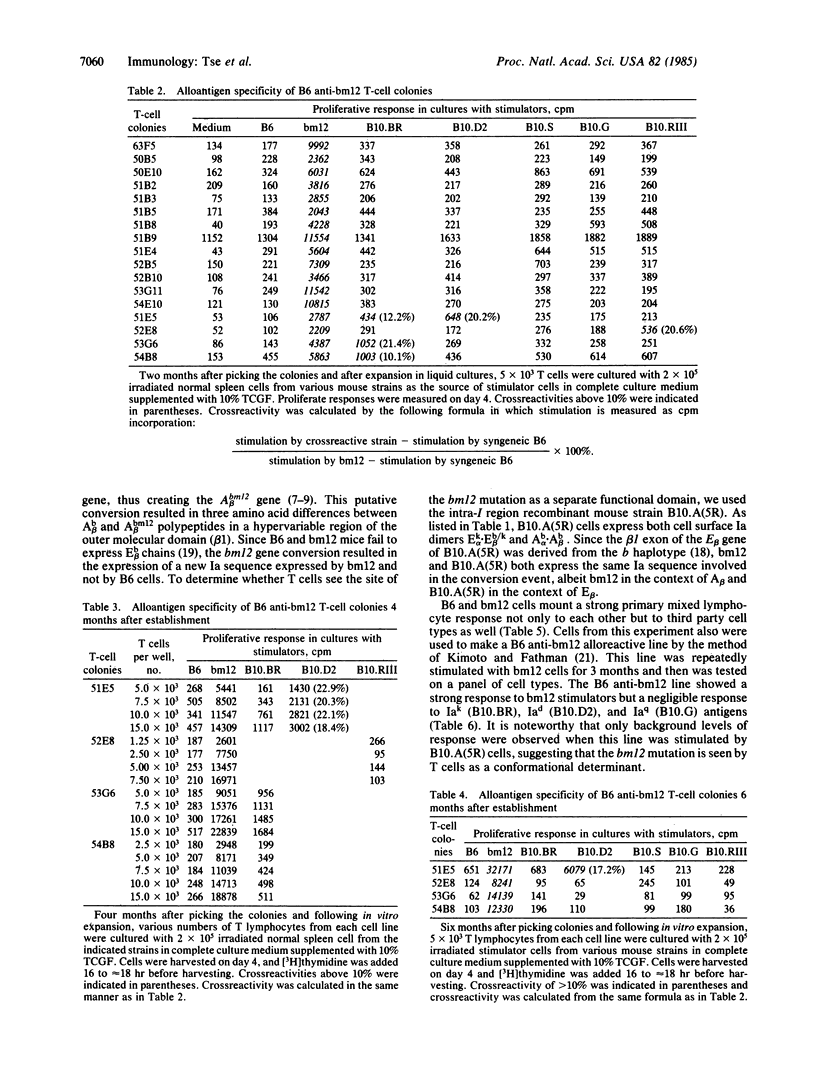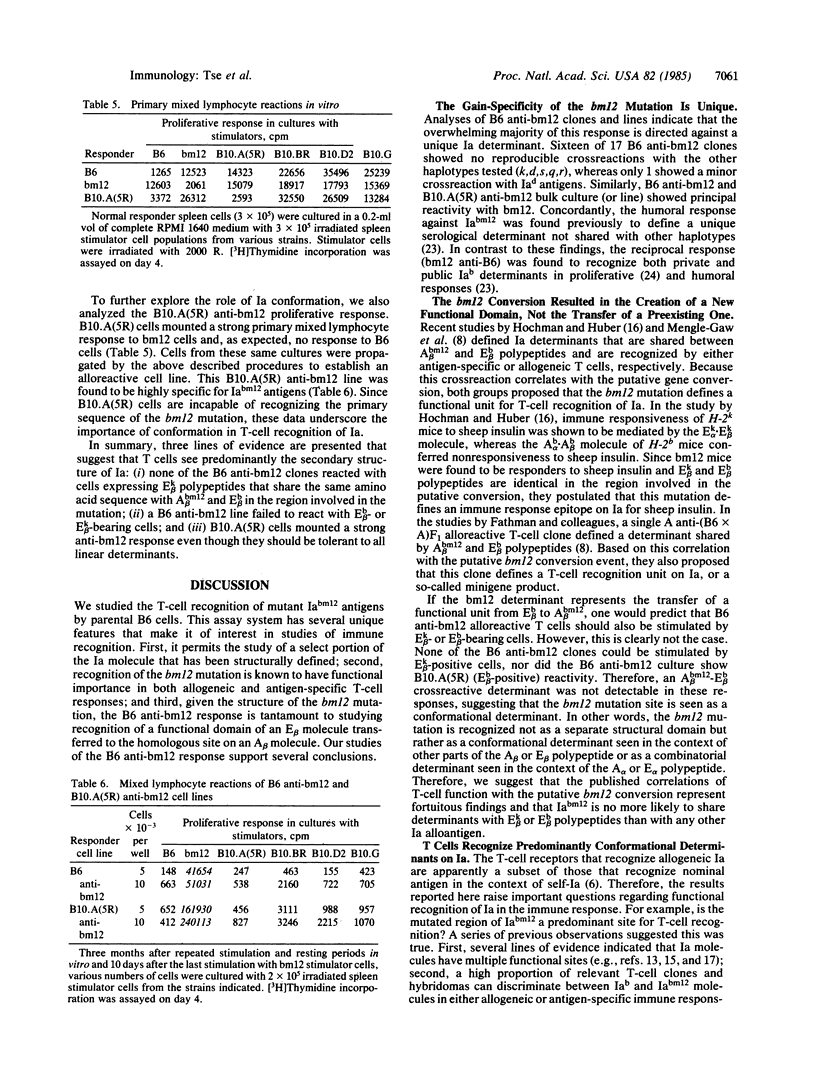Abstract
The structure of the highly polymorphic Ia dimer is the genetically determined factor that controls the immune response to foreign antigens, albeit the mechanism remains unresolved. However, it is clear that, in diverse immune responses, effector T lymphocytes require recognition of self-Ia and foreign antigenic determinants on the surface of an antigen-presenting cell or an antibody-secreting B cell. Furthermore, a single Ia molecule has been found to possess several independently acting functional domains. In this report T-cell recognition of Ia was limited to a single, defined structure by using the Ia mutant mouse strain B6.C-H-2bm12 (bm12). The Ia determinant being recognized is the site of the mutation that represents a difference in three of five amino acid residues in a hypervariable region of its beta chain. This mutation has been proposed to have resulted from a gene conversion-like event and is known to have functional importance. Recognition of the bm12 mutation site was studied here in in vitro cultures of T cells generated against Iabm12 antigens. The specificity of these alloreactive T cells was tested by using stimulator cells expressing various Ia alloantigens of known structure. Our findings provide direct genetic evidence that T cells recognize predominantly conformational determinants on Ia molecules and not their primary structure. The implications of these findings on our understanding of the genetic control of the immune response and the potential to modulate these responses in an antigen-specific way are discussed.
Full text
PDF




Selected References
These references are in PubMed. This may not be the complete list of references from this article.
- Beck B. N., Nelson P. A., Fathman C. G. The I-Ab mutant B6.C-H-2bm12 allows definition of multiple T cell epitopes on I-A molecules. J Exp Med. 1983 May 1;157(5):1396–1404. doi: 10.1084/jem.157.5.1396. [DOI] [PMC free article] [PubMed] [Google Scholar]
- Berkower I., Buckenmeyer G. K., Gurd F. R., Berzofsky J. A. A possible immunodominant epitope recognized by murine T lymphocytes immune to different myoglobins. Proc Natl Acad Sci U S A. 1982 Aug;79(15):4723–4727. doi: 10.1073/pnas.79.15.4723. [DOI] [PMC free article] [PubMed] [Google Scholar]
- Buchmüller Y., Corradin G. Lymphocyte specificity to protein antigens. V. Conformational dependence of activation of cytochrome c-specific T cells. Eur J Immunol. 1982 May;12(5):412–416. doi: 10.1002/eji.1830120510. [DOI] [PubMed] [Google Scholar]
- Glimcher L. H., Schroer J. A., Chan C., Shevach E. M. Fine specificity of cloned insulin-specific T cell hybridomas: evidence supporting a role for tertiary conformation. J Immunol. 1983 Dec;131(6):2868–2874. [PubMed] [Google Scholar]
- Hochman P. S., Huber B. T. A class II gene conversion event defines an antigen-specific Ir gene epitope. J Exp Med. 1984 Dec 1;160(6):1925–1930. doi: 10.1084/jem.160.6.1925. [DOI] [PMC free article] [PubMed] [Google Scholar]
- Janeway C. A., Wigzell H., Binz H. Two different VH gene products make up the T-cell receptors. Scand J Immunol. 1976;5(9):993–1001. doi: 10.1111/j.1365-3083.1976.tb03051.x. [DOI] [PubMed] [Google Scholar]
- Kanamori S., Walsh W. D., Hansen T. H., Tse H. Y. Assessment of antigen-specific restriction sites on Ia molecules as defined by the bm12 mutation. J Immunol. 1984 Dec;133(6):2811–2814. [PubMed] [Google Scholar]
- Kaufman J. F., Auffray C., Korman A. J., Shackelford D. A., Strominger J. The class II molecules of the human and murine major histocompatibility complex. Cell. 1984 Jan;36(1):1–13. doi: 10.1016/0092-8674(84)90068-0. [DOI] [PubMed] [Google Scholar]
- Kaye J., Janeway C. A., Jr The Fab fragment of a directly activating monoclonal antibody that precipitates a disulfide-linked heterodimer from a helper T cell clone blocks activation by either allogeneic Ia or antigen and self-Ia. J Exp Med. 1984 May 1;159(5):1397–1412. doi: 10.1084/jem.159.5.1397. [DOI] [PMC free article] [PubMed] [Google Scholar]
- Kimoto M., Fathman C. G. Antigen-reactive T cell clones. II. Unique homozygous and (high responder x low responder)F1 hybrid antigen-presenting determinants detected using poly(Tyr, Glu)-poly D, L-Ala--poly Lys-reactive T cell clones. J Exp Med. 1981 Feb 1;153(2):375–385. doi: 10.1084/jem.153.2.375. [DOI] [PMC free article] [PubMed] [Google Scholar]
- Lei H. Y., Melvold R. W., Miller S. D., Waltenbaugh C. Gain/loss of poly(Glu50Tyr50)/poly(Glu60Ala30Tyr10) responsiveness in the bm12 mutant strain. J Exp Med. 1982 Aug 1;156(2):596–609. doi: 10.1084/jem.156.2.596. [DOI] [PMC free article] [PubMed] [Google Scholar]
- Lin C. C., Rosenthal A. S., Passmore H. C., Hansen T. H. Selective loss of antigen-specific Ir gene function in IA mutant B6.C-H-2bm12 is an antigen presenting cell defect. Proc Natl Acad Sci U S A. 1981 Oct;78(10):6406–6410. doi: 10.1073/pnas.78.10.6406. [DOI] [PMC free article] [PubMed] [Google Scholar]
- Mathis D. J., Benoist C., Williams V. E., 2nd, Kanter M., McDevitt H. O. Several mechanisms can account for defective E alpha gene expression in different mouse haplotypes. Proc Natl Acad Sci U S A. 1983 Jan;80(1):273–277. doi: 10.1073/pnas.80.1.273. [DOI] [PMC free article] [PubMed] [Google Scholar]
- McIntyre K. R., Seidman J. G. Nucleotide sequence of mutant I-A beta bm12 gene is evidence for genetic exchange between mouse immune response genes. Nature. 1984 Apr 5;308(5959):551–553. doi: 10.1038/308551a0. [DOI] [PubMed] [Google Scholar]
- McKenzie I. F., Morgan G. M., Sandrin M. S., Michaelides M. M., Melvold R. W., Kohn H. I. B6.C-H-2bm12. A new H-2 mutation in the I region in the mouse. J Exp Med. 1979 Dec 1;150(6):1323–1338. doi: 10.1084/jem.150.6.1323. [DOI] [PMC free article] [PubMed] [Google Scholar]
- Mengle-Gaw L., Conner S., McDevitt H. O., Fathman C. G. Gene conversion between murine class II major histocompatibility complex loci. Functional and molecular evidence from the bm 12 mutant. J Exp Med. 1984 Oct 1;160(4):1184–1194. doi: 10.1084/jem.160.4.1184. [DOI] [PMC free article] [PubMed] [Google Scholar]
- Michaelides M., Sandrin M., Morgan G., McKenzie I. F., Ashman R., Melvold R. W. Ir gene function in an I-A subregion mutant B6.C-H-2bm12. J Exp Med. 1981 Feb 1;153(2):464–469. doi: 10.1084/jem.153.2.464. [DOI] [PMC free article] [PubMed] [Google Scholar]
- Morgan G. M., McKenzie I. F., Melvold R. W. The definition of a new Ia antigenic specificity using the B6.C-H-2bml2 I-region mutant strain. Immunogenetics. 1980 Jul;11(1):1–6. doi: 10.1007/BF01567764. [DOI] [PubMed] [Google Scholar]
- Sherman L. A. Recognition of conformational determinants on H-2 by cytolytic T lymphocytes. Nature. 1982 Jun 10;297(5866):511–513. doi: 10.1038/297511a0. [DOI] [PubMed] [Google Scholar]
- Shevach E. M., Rosenthal A. S. Function of macrophages in antigen recognition by guinea pig T lymphocytes. II. Role of the macrophage in the regulation of genetic control of the immune response. J Exp Med. 1973 Nov 1;138(5):1213–1229. doi: 10.1084/jem.138.5.1213. [DOI] [PMC free article] [PubMed] [Google Scholar]
- Skelly R. R., Pappas F., Koprak S., Ahmed A., Hansen T. H. T cell responses to select Ia determinants using the I-A mutant mouse strain B6.C-H-2bm12. J Immunol. 1982 Nov;129(5):2094–2097. [PubMed] [Google Scholar]
- Sprent J. Restricted helper function of F1 hybrid T cells positively selected to heterologous erythrocytes in irradiated parental strain mice. II. Evidence for restrictions affecting helper cell induction and T-B collaboration, both mapping to the K-end of the H-2 complex. J Exp Med. 1978 Apr 1;147(4):1159–1174. doi: 10.1084/jem.147.4.1159. [DOI] [PMC free article] [PubMed] [Google Scholar]
- Sredni B., Tse H. Y., Chen C., Schwartz R. H. Antigen-specific clones of proliferating T lymphocytes. I. Methodology, specificity, and MHC restriction. J Immunol. 1981 Jan;126(1):341–347. [PubMed] [Google Scholar]
- Steinmetz M., Minard K., Horvath S., McNicholas J., Srelinger J., Wake C., Long E., Mach B., Hood L. A molecular map of the immune response region from the major histocompatibility complex of the mouse. Nature. 1982 Nov 4;300(5887):35–42. doi: 10.1038/300035a0. [DOI] [PubMed] [Google Scholar]
- Tse H. Y., Mond J. J., Paul W. E. T lymphocyte-dependent B lymphocyte proliferative response to antigen. I Genetic restriction of the stimulation of B lymphocyte proliferation. J Exp Med. 1981 Apr 1;153(4):871–882. doi: 10.1084/jem.153.4.871. [DOI] [PMC free article] [PubMed] [Google Scholar]
- Tse H. Y., Schwartz R. H., Paul W. E. Cell-cell interactions in the T cell proliferative response. I. Analysis of the cell types involved and evidence for nonspecific T cell recruitment. J Immunol. 1980 Aug;125(2):491–500. [PubMed] [Google Scholar]
- Widera G., Flavell R. A. The nucleotide sequence of the murine I-E beta b immune response gene: evidence for gene conversion events in class II genes of the major histocompatibility complex. EMBO J. 1984 Jun;3(6):1221–1225. doi: 10.1002/j.1460-2075.1984.tb01956.x. [DOI] [PMC free article] [PubMed] [Google Scholar]
- Yoshioka M., Bixler G. S., Jr, Atassi M. Z. Preparation of T-lymphocyte lines and clones with specificities to preselected protein sites by in vitro passage with free synthetic peptides: demonstration with myoglobin sites. Mol Immunol. 1983 Oct;20(10):1133–1137. doi: 10.1016/0161-5890(83)90123-2. [DOI] [PubMed] [Google Scholar]
- de Waal L. P., Melief C. J., Melvold R. W. Cytotoxic T lymphocytes generated across and I-Ab mutant difference are directed against a molecule bearing Ia antigens. Eur J Immunol. 1981 Mar;11(3):258–265. doi: 10.1002/eji.1830110317. [DOI] [PubMed] [Google Scholar]


